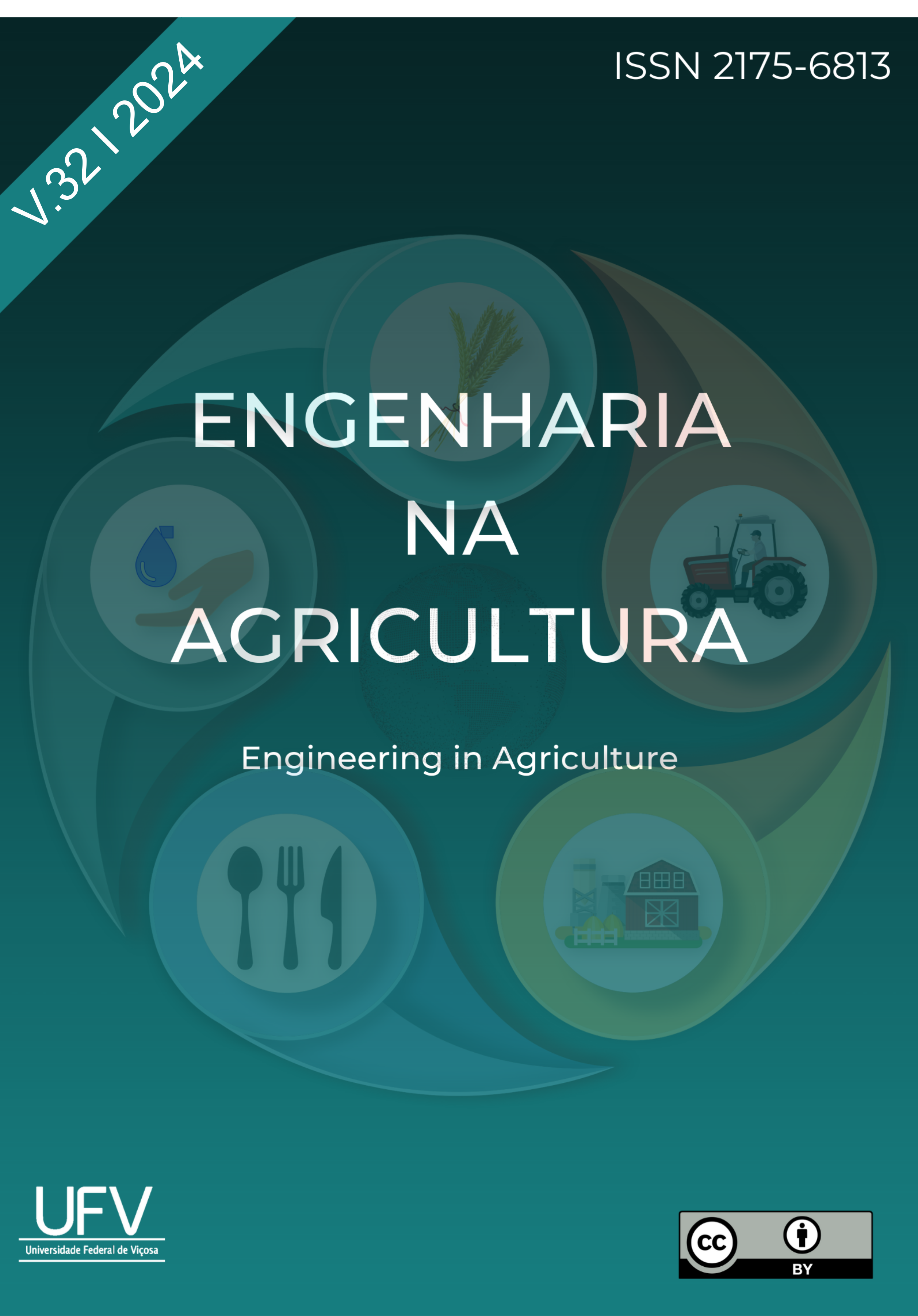Fertilizer application depth and soil water content: Effect on seed plantability of a seeder in direct planting
DOI:
https://doi.org/10.13083/reveng.v32i1.15061Palavras-chave:
Direct seeding, Phaseolus vulgaris L., Seedling spacingResumo
Mechanization is key to increasing efficiency and productivity in agriculture. Therefore, it is important to understand these machines and their operating conditions to assess whether the quality of equipment operation has been satisfactory. Furthermore, planting windows have become increasingly narrower; therefore, an efficient planting operation is essential to ensure uniform stands with high yields. The objective of this study was to evaluate the effects of three soil water contents (28.7; 36.4 and 47.6%) and three fertilizer application depths (6.3; 11.3 and 14.8 cm) on the seed plantability of a direct planting machine. The experiment was arranged in a split-plot randomized block design, with three replications. The water contents were assigned to the plots and the fertilizer depths to the subplots.
Downloads
Referências
ALVARES, A. A.; STAPE, J. L.; SENTELHAS, P. C.; GONÇALVES, J. L. M.; SPAROVEK, G. Köeppen’s climate classification map for Brazil. Meteorologische Zeitschrift, v.22, n.6, p. 711-728, 2014.
BERNARDES, S. M.; REGAZZO, J. M.; SILVA, T. L; BAESSO, M. M. Avaliação de desempenho de semeadora-adubadora: Seeder-fertilizer performance evaluation. Brazilian Journal of Animal and Environmental Research, v. 6, n.1, p.587-599, 2023.
COMPANHIA NACIONAL DE ABASTECIMENTO - CONAB. Acompanhamento da safra brasileira de grãos, v.11– Safra 2023/24, n.2 - Décimo segundo levantamento, Brasília, p.1-111, novembro 2023.
EDMOND, J. B.; DRAPALA, W. L. The effects of temperature, sand and oil, and acetone on germination of okra seed. Proceedings of the American Society for Horticultural Science., v.71, p.428-434, 1958.
EMPRESA BRASILEIRA DE PESQUISA AGROPECUÁRIA - EMBRAPA. Centro Nacional de Pesquisa de Solos. Manual de métodos de análise do solo. 3. ed. rev. e ampl. Brasília, DF, 2017. 573 p.
EMPRESA BRASILEIRA DE PESQUISA AGROPECUÁRIA - EMBRAPA. Sistema Brasileiro de Classificação de Solos. 5. Ed. Brasília, DF., 2018. 590 p
INSTITUTO BRASILEIRO DE GEOGRAFIA E ESTATÍSTICA - IBGE. Censo Agropecuário, 2017. Available in: https:// https://sidra.ibge.gov.br/Tabela/6856. Acesso em 30 maio 2022.
KURACHI, S. A. H.; COSTA, J. A. S.; BERNARDI, J. A.; COELHO, J. L. O.; Silveira, G. M. Avaliação tecnológica de semeadoras e/ou adubadoras: tratamento de dados de ensaios e regularidade de distribuição longitudinal de sementes. Bragantia, v.48, p.49 - 62, 1989.
R CORE TEAM (2017). R: a language and environment for statistical computing. R Foundation for Statistical Computing, Vienna, Austria. Available in: https://www.R-project.org/. Acesso em: 20 maio 2022.
RINALDI, P. C.; FERNANDES, H. C.; TEIXEIRA, M. M.; SILVEIRA, J. C. M.; JUNIOR, R. G. M. Influência da profundidade de adubação e da velocidade de uma semeadora no estabelecimento inicial da cultura do feijão (Phaseolus vulgaris, L.). Revista Engenharia na Agricultura, v.18, n.2, p.123-130, 2010.
SILVA, J.G.; SILVEIRA, P.M. Avaliação de uma semeadora adubadora na cultura do milho. Santo Antônio de Goiás, GO: Embrapa Arroz e Feijão, 2002. 19 p. (Boletim de Pesquisa e Desenvolvimento 2; dezembro/2002).
SILVA, F. J.; OLIVEIRA, C. A. A.; SILVA ALMEIDA, L.; LIMA, L. P.; GUIMARÃES, E. C. Variabilidade espacial da resistência do solo à penetração e da produtividade do milho. Revista de Agricultura Neotropical, v.4, n.3, p.77-84, 2017.
VALADÃO, F. C. A.; WEBER, O. L.; VALADÃO JUNIOR, D. D.; SCARPINELLI, A.; DEINA, F. R.; BIANCHINI, A. Adubação fosfatada e compactação do solo: sistema radicular da soja e do milho e atributos físicos do solo. Revista Brasileira de Ciência do Solo, v.39, n.1, p.243-255, 2015.
Downloads
Publicado
Como Citar
Edição
Seção
Licença
Copyright (c) 2024 Revista Engenharia na Agricultura - REVENG

Este trabalho está licenciado sob uma licença Creative Commons Attribution-NonCommercial 4.0 International License.
Autores que publicam nesta revista concordam com os seguintes termos:
O(s) autor(es) autoriza(m) a publicação do texto na da revista;
O(s) autor(es) garantem que a contribuição é original e inédita e que não está em processo de avaliação em outra(s) revista(s);
A revista não se responsabiliza pelas opiniões, ideias e conceitos emitidos nos textos, por serem de inteira responsabilidade de seu(s) autor(es);
É reservado aos editores o direito de proceder a ajustes textuais e de adequação às normas da publicação.
A partir da submissão, o autor estará cedendo integralmente seus direitos patrimoniais da obra à publicação, permanecendo detentor de seus direitos morais (autoria e identificação na obra) e de acordo com a Licença Creative Commons, CC BY-NC.








 Esta obra está licenciada com uma Licença
Esta obra está licenciada com uma Licença 